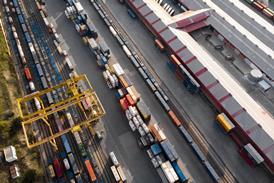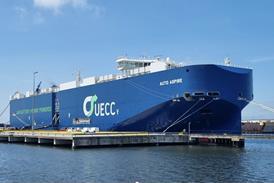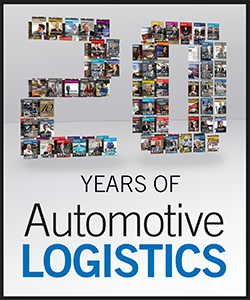This article kicks off a series of pieces celebrating Automotive Logistics’ 20th anniversary issue that together take an extended look at the way top executives feel automotive production and logistics have changed in the last two decades – and where they see them heading in the future.
 Twenty years is but a few sunsets in the history of the logistics industry. Transporting goods is as old as trade itself, while its meaning for organising supply and distribution goes back to the ancient Greek and Roman militaries, in which Logistikas were responsible for providing soldiers with necessary resources. Worldwide trade connections are also not new, from the ancient Egyptians to the East India Company. Even logistics’ more recent breakthroughs, including the growth of the ocean container, barcodes and electronic data interchange (EDI), mostly gained ground in the middle of the last century. Indeed, some developments happening today are revivals of the past, such as China’s ‘One Belt, One Road’ recreation of the Silk Road across Asia to the Mediterranean Sea.
Twenty years is but a few sunsets in the history of the logistics industry. Transporting goods is as old as trade itself, while its meaning for organising supply and distribution goes back to the ancient Greek and Roman militaries, in which Logistikas were responsible for providing soldiers with necessary resources. Worldwide trade connections are also not new, from the ancient Egyptians to the East India Company. Even logistics’ more recent breakthroughs, including the growth of the ocean container, barcodes and electronic data interchange (EDI), mostly gained ground in the middle of the last century. Indeed, some developments happening today are revivals of the past, such as China’s ‘One Belt, One Road’ recreation of the Silk Road across Asia to the Mediterranean Sea.
Logistics has always been essential in the history of the automobile, particularly since the onset of mass production. When Henry Ford built his original factories around a century ago – including the River Rouge plant in Detroit, Dagenham near London, Cologne in Germany – they were all situated near to water and rail transport. Some aspects of those operations, including barge and ferry freight along the Rhine and Thames rivers, are still in use today. Their principles have been applied far and wide.
This article kicks off a series of pieces celebrating Automotive Logistics’ 20th anniversary issue that together take an extended look at the way top executives feel automotive production and logistics have changed in the last two decades – and where they see them heading in the future.
See also:
Production & logistics part 2: Questioning the future
Production & logistics part 3: Operations, packaging and IT
Production & logistics part 4: Logistics organisations and skills
More recently, the switch to low inventory, just-in-time production owes much to the logistics methods that Japanese carmakers developed in the 1970s and 1980s, which privileged frequent transport flows over stockpiling inventory.
Today, the basic processes and transport equipment for inbound, production and vehicle logistics are not radically different to 20 or 30 years ago (though a different case can be made for aspects of service parts logistics). Some transport assets – containers, rail wagons, vessels – are the same ones still in use. IT infrastructure can be also be surprisingly similar. Even as cloud-based systems gain influence, manufacturers often rely on mainframe systems developed decades ago, which require interfaces and add-ons to communicate with other systems. EDI and advance shipping notices (ASNs) are technology of the 1970s and 1980s. The Excel spreadsheet, though often mocked as the tool of a bygone manual era, is still common.
And yet, much has changed in technology and the automotive industry since the late 1990s. The increase in internet speeds, mobile communication, data capture and connectivity across society has been tremendous, especially for the logistics industry. The rise of Amazon, founded in the early 1990s as an online bookstore, has changed how consumers buy products, and especially their expectations for tracking and receiving deliveries.
The ‘Amazon effect’ is often discussed among automotive logistics executives, though often over what hasn’t happened as much as what has. Technologies that enable more real-time visibility, like RFID, have been discussed for years, though use is still isolated. Most carmakers rely on bulk processing of data via EDI, rather than the more instantaneous transmissions allowed by application program interface (API), which is more commonly used by online retailers . Manufacturers still complain about visibility of their own returnable packaging, while streamlined vehicle delivery in an Amazon-style portal remains elusive. ‘Big data’ and ‘predictive data analytics’, though of great interest to OEM logistics executives, are still largely aspirational pursuits.
But, as interviews with senior decision-makers in automotive logistics show, dismissing the past 20 years as time spent trying and failing to improve visibility and connectivity would be to ignore considerable progress. Executives agree that even if the essential processes for automotive logistics remain similar, operational complexity has risen exponentially. There are now a greater variety of parts combinations and logistics flows coming into any automotive plant or logistics centre than the human brain (even with a spreadsheet) can compute.
[mpu_ad]The supply chain depends immensely on data visibility. Electronic links, while perhaps not the most sophisticated, are nevertheless the norm, while network planning and optimisation have been digitalised. All this has allowed manufacturers to reduce inventory further and transport loads more frequently, with algorithms used to change and re-engineer flows. Companies are also integrating GPS, telematics and other real-time information with inventory and other production data. They are also using more cloud-based IT systems and open interfaces.
This focus on continuous optimisation has helped keep logistics costs reasonably in line with sales, even if input costs – including labour, fuel, tolls and regulations – have risen across supply chains that are themselves longer. Delivery lead times, while not always faster, are more reliable and flexible despite component and model variety. Tracking finished vehicle arrival times may not yet be a science, but it has become a skilled art form, offering more visibility on shipping and flexibility even amidst manufacturing changes.
The better to see you, my dearOver the past 20 years, the industry’s growing thirst for data has not been sated. For logistics and supply chain managers, so much of what impacts operations – geographical and infrastructure challenges, economic crises, product technology, natural disasters, political turmoil – is external to what they can control, and must be mitigated. Supply chain managers gain the upper hand when they can see and anticipate, whether short-term issues such as bad weather impacting on the transport network and supplier bottlenecks, or longer-term effects from other departments whose decisions shape the supply chain.
Consider the degree to which carmakers were caught off guard about their own supply chains during disruptions like the US west coast port lockout of 2002, the Icelandic volcanic ash cloud in 2010, the Japanese tsunami in 2011, or supplier disputes that shut down plants across continents. Such disruptions teach manufacturers about the deeper layers of the supply chain, and most aspire to have better links with suppliers and providers so they can see what is below the murky surface before it’s too late. To do that, executives stress that the industry needs systems that speak to one another across companies, languages and interfaces, while internally departments must also share plans, data and budgets to help make joint decisions.
To this end, there has been progress over the past 20 years, as logistics departments have gained responsibilities and influence vis-à-vis other divisions. In the late 1990s, some manufacturers didn’t even have central logistics departments, but rather a collection of plant or country-based teams. Today, there are more global or wider regional logistics organisations leading not only on logistics, but also on capacity and constraints management, while playing a bigger role in sales volume planning, purchasing and plant decisions.
What’s more, there is a changing cultural view of logistics. In 1997, logistics was in ways still viewed as the necessary evil to get from A to B, perhaps via X. For carmakers, it was a cost that many considered to add little value. Today, in a society increasingly focused on mobility, in which e-commerce has made goods delivery an even more visible part of everyday life, logistics can be more than a cost: a competitive factor, and an enabler of new technology, markets and processes.
To sustain and increase this influence, supply chain organisations increasingly need people versed in technology and systems and flexible enough to adapt further to change. The evolution of the automotive supply chain and logistics manager into a highly skilled, tech-savvy leader is likely to be one of the most vital steps for automotive logistics ahead of further evolutions, including electrification and autonomous driving, and ‘industry 4.0’ processes in manufacturing.
For all the equipment and technology, many aspects of the logistics chain – whether 3PL contracts, IT integration or packaging design – depend strongly on relationships, communication and trust. That machines and systems have a greater role to play in the supply chain is not in dispute. Most carmakers are looking to self-organising logistics systems, fully autonomous transport robots, as well as parts picking and kitting robots, analytics and big data, and autonomous trucks and warehouses. However, executives confirm that they will depend more than ever on having the right people and providers to steer them. Even if there are fewer people involved in a given process, the way people work together and communicate will be just as important, if not more so – and in that way, no different than at any time before.
Production & logistics part 1: Where are we now?
- 1
 Currently reading
Currently readingProduction & logistics part 1: Where are we now?
- 2
- 3
- 4







































